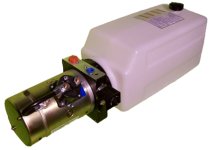I have a vacuum machine for picking up horse manure in the field. The dung is collected in a 1 cubic metre hopper which can be dumped with the Stone electric pump and a single acting hydraulic cylinder. That works fine -- so long as the manure slides out! Sometimes it doesn't and there is no way the hopper will return to normal (horizontal) position unassisted. As the back door it now facing downwards, within about six inches of the ground, it is impossible to fork the material out. The solution is to put a hose pipe into the hopper and hope the wetted material will slide out in time!
I'd like to convert the dump using a double acting cylinder so the hopper can be up righted using the hydraulic pump. At least, then, it can be forked out manually or the manure loosened so it slides out.
Would it work if I use the exisiting single acting pump with a manual diverter valve and replace the single acting cylinder with a double acting cylinder? I think I would need to make some provision for the hydraulic fluid to drain back into the tank. Maybe through a modified filler cap? Is there anything else I should be aware of? I am new to hydraulics but it occurs to me that the system I want will be something on the lines of a hydraulic log splitter? I see that Stone also make double acting pumps, but I'm hoping I won't need one of those.
Incidentaly, the cylinder has one connection for the fluid and also a blanking plate at the other end of the cylinder. I had assumed this latter was a breather but there doesn't seem to be a hole in it. Is there any chance this could be modified to be double acting? Pump is illustrated below.
Thanks for your time.
I'd like to convert the dump using a double acting cylinder so the hopper can be up righted using the hydraulic pump. At least, then, it can be forked out manually or the manure loosened so it slides out.
Would it work if I use the exisiting single acting pump with a manual diverter valve and replace the single acting cylinder with a double acting cylinder? I think I would need to make some provision for the hydraulic fluid to drain back into the tank. Maybe through a modified filler cap? Is there anything else I should be aware of? I am new to hydraulics but it occurs to me that the system I want will be something on the lines of a hydraulic log splitter? I see that Stone also make double acting pumps, but I'm hoping I won't need one of those.
Incidentaly, the cylinder has one connection for the fluid and also a blanking plate at the other end of the cylinder. I had assumed this latter was a breather but there doesn't seem to be a hole in it. Is there any chance this could be modified to be double acting? Pump is illustrated below.
Thanks for your time.

